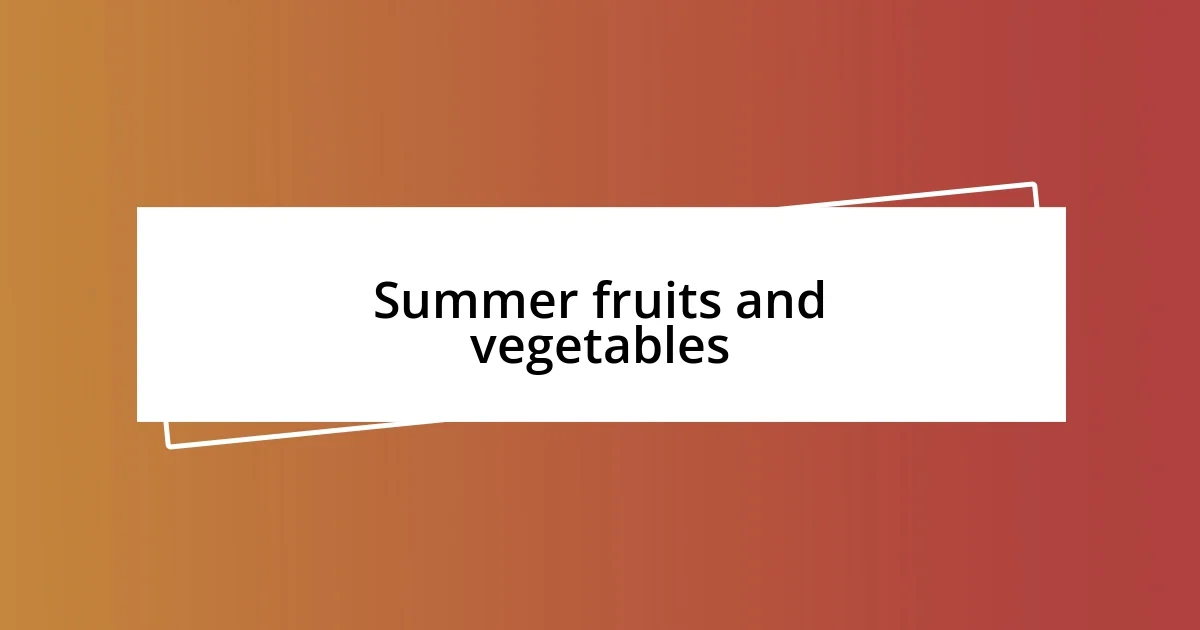Key takeaways:
- Seasonal produce enhances flavor, nutrition, and emotional connections, offering a diverse array of fruits and vegetables throughout the year.
- Eating seasonally supports local farmers, is cost-effective, and benefits the environment by reducing transportation and packaging waste.
- Proper storage techniques for seasonal produce, like keeping apples in a cool place and wrapping leafy greens in damp paper towels, can significantly prolong freshness and enjoyment.

Seasonal produce overview
Seasonal produce is like a vibrant palette that changes with the rhythm of the seasons, offering a delightful array of flavors and nutrients. I can’t help but feel a sense of excitement when the first strawberries emerge in spring; their sweetness brings back memories of warm, sunny days spent picking fresh fruit with my family. Isn’t it fascinating how food can evoke such powerful emotions and memories?
As the seasons shift, so do the vegetables that grace our tables. I recall the crispness of fall when root vegetables like beets and carrots become staples in my kitchen. There’s something incredibly comforting about roasting them until they caramelize—who wouldn’t want to bask in that warm, earthy aroma? How does the food we eat manage to wrap us in nostalgia and warmth like a cozy blanket?
Understanding seasonal produce not only enriches our diets but also supports local farmers and reduces environmental impact. I often find myself wandering through farmers’ markets, amazed at how the vibrant displays reflect nature’s calendar. Have you ever noticed how those colorful displays invite us to explore new tastes and recipes? It’s a delightful reminder of how intertwined our food choices are with the world around us.

Benefits of eating seasonally
Eating seasonally is not just about enjoying fresh flavors; it also offers a wealth of benefits for our bodies and the planet. When I indulge in produce that’s in season, I notice the taste is often more robust and the nutrients more plentiful. For instance, biting into a sun-ripened peach in late summer is an experience that far surpasses its out-of-season counterparts. It’s a sensory treat that reminds me how food can be an intense connection to nature’s rhythm.
Here are some benefits of eating seasonally:
- Nutritional Quality: Seasonal produce is generally harvested at its peak ripeness, ensuring it’s packed with vitamins and minerals.
- Enhanced Flavor: Foods grown in their natural season often taste better, as they are picked fresh and not shipped long distances.
- Support for Local Farmers: Purchasing seasonal fruits and vegetables from local farmers strengthens the community and fosters sustainable agricultural practices.
- Cost-Effectiveness: Seasonal produce is often more affordable since it’s abundant and less reliant on storage and transportation costs.
- Environmental Benefits: Eating seasonally reduces the carbon footprint by minimizing transportation and unnecessary packaging.
These small choices can lead to a healthier lifestyle and a more sustainable planet, and I genuinely find joy in supporting our local ecosystem. Each bite I take not only satisfies my taste buds but also fills me with a sense of purpose, knowing I’m making a positive impact.

Top spring produce finds
Spring is an exciting time for discovering new produce, and I’ve found some incredible gems that make my meals truly vibrant. One standout for me is asparagus. The tender, green spears seem to pop up almost overnight, and there’s nothing like tossing them in olive oil and roasting them until they’re lightly charred. The earthy flavor and satisfying crunch always remind me of picnics in the park, where we’d pair them with fresh bread and a simple dip. What do you associate with the arrival of asparagus?
Another delightful find is radishes. Their bright colors and crisp texture add a refreshing crunch to salads that can awaken even the dullest lunch. I remember experimenting with them in a spring salad, pairing their peppery bite with sweet strawberries and a splash of balsamic. The combination sparked a burst of flavors, making it a go-to dish that I still enjoy sharing with friends.
Lastly, let’s not forget about peas! When I first bite into fresh peas, I’m transported to my grandmother’s garden, where we’d pick them straight from the vine, enjoying the sweet burst of flavor in every pod. Peas are incredibly versatile; I often toss them in pasta, delighting in their bright green color and sweetness. Isn’t it wonderful how these seasonal produce finds can bring back cherished memories while creating new culinary experiences?
| Produce | Notes |
|---|---|
| Asparagus | Roasted until charred; reminds me of park picnics. |
| Radishes | Crisp and peppery; great in salads. |
| Peas | Sweet and nostalgic; perfect for pasta dishes. |

Summer fruits and vegetables
Nothing says summer quite like the explosion of colors and flavors in the fruit aisle. I’m always exhilarated by the arrival of juicy watermelons, their sweetness reminding me of summer barbecues with friends. I recall sitting on the patio, sharing slices of watermelon, the juice running down our chins, as laughter filled the air. Don’t you just love how certain fruits can evoke memories of carefree summer days?
My love for summer vegetables often leads me to heirloom tomatoes. Each time I slice into one, I feel like I’m unearthing a hidden treasure. The vibrant reds, yellows, and greens seem to dance on the cutting board. I cherish them in salads, drizzled with a bit of balsamic glaze; their rich flavor instantly brightens any dish. Have you ever experienced the joy of creating a simple yet fantastic caprese salad with fresh basil? It truly captures the essence of summer.
I can’t overlook the magical taste of summer berries, either. Ripe strawberries, blueberries, and raspberries are my go-to snacks, and I often find myself indulging in a bowl filled with a medley of them on lazy afternoons. The burst of sweetness is not just delightful; it goes hand in hand with a sense of nostalgia, reminding me of visits to local farms where I’d pick them right off the bush. Isn’t it incredible how connecting with our food can deepen our appreciation for it?

Fall produce treasures
One of my absolute favorite fall treasures is the rich and vibrant butternut squash. I remember the first time I roasted a whole squash, its sweet aroma filling my kitchen. When I finally sliced into it, the deep orange color practically glowed, and I couldn’t wait to blend it into a velvety soup. Isn’t it amazing how a simple ingredient like squash can transform into something so comforting on a cool autumn evening?
Another delightful fall find is the crisp apple. Each bite into a freshly picked apple is like a burst of fall itself. I often visit apple orchards this time of year; the joy of picking them off the tree while surrounded by colorful leaves brings a smile to my face. Whether I’m enjoying them raw, baking a pie, or making homemade applesauce, they always add a touch of nostalgia and warmth to my meals. Have you ever tried that warm apple cider that fills your home with cozy scents of cinnamon and nutmeg?
Lastly, I can’t pass up the gorgeous variety of pears in fall. They’re so versatile! I love poaching them in red wine for a sophisticated dessert, but sometimes, I just enjoy them right off the counter, savoring their juicy sweetness. Each time I sink my teeth into a perfectly ripe pear, I’m reminded of autumn picnics with friends, where we would slice them up and pair them with cheese and honey—it’s such a simple pleasure! What’s your favorite way to enjoy pears in the fall?

Winter harvest highlights

Winter harvest highlights
When winter rolls around, I find myself reaching for hearty root vegetables like carrots and parsnips. Their earthy sweetness becomes such a crucial part of my comfort meals. I love roasting them together, drizzled with olive oil and sprinkled with fresh herbs. The transformation in flavor is simply magical—each bite bursts with cozy goodness that warms me up on chilly evenings. Have you ever experienced that delightful crunch, paired with a hint of caramelization from the oven?
One of my favorite winter discoveries is brussels sprouts. I remember the first time I tried them roasted—they were caramelized and crispy, a far cry from the boiled versions I had growing up. Now, I can’t resist tossing them in spicy buffalo sauce as a side dish; the contrast of flavors turns them into my go-to indulgence. Isn’t it surprising how the humble brussels sprout can transform into something so spectacular? Every bite brings a joy that’s simply unforgettable.
And how could I forget about the velvety kale? It’s such a versatile leafy green, and I find myself adding it to everything from soups to smoothies during the winter months. There’s something so satisfying about massaging a drizzle of olive oil and lemon juice into fresh leaves; it transforms into this deliciously tender salad that feels nutritious and refreshing. Have you ever felt that burst of energy from enjoying a fresh kale salad on a gray winter day? It’s one of my little joys that truly lifts my spirits.

Tips for storing seasonal produce
When it comes to storing seasonal produce, I’ve learned that a little care goes a long way. For instance, I used to toss my apples in the fridge without a second thought. However, I’ve discovered that keeping them in a cool, dark place like my pantry not only maintains their crispness but also enhances their flavor—who doesn’t love a perfectly crunchy apple?
For vegetables such as butternut squash, I prefer storing them in a cool area away from direct sunlight. I once made the mistake of leaving one on my counter too close to the window, thinking the sunlight wouldn’t harm it. A couple of days later, it was soft and unappetizing. Now, I always ensure these beauties are stored in a breathable bag so they can last longer while retaining their natural sweetness. Have you ever had a moment where just a few simple changes made a world of difference?
Lastly, I find that leafy greens like kale deserve special treatment. Rather than stuffing them in a bag, I wrap them loosely in a damp paper towel before placing them in the refrigerator. This little trick helps to keep them crisp and vibrant. I remember the first time I opened my fridge to find perfectly fresh leaves after using this method—it felt like a small victory that inspired me to whip up a nourishing salad right away. It’s those little joys, found in the simplicity of caring for my food, that enhance my cooking experience!














